#dosm
Explore tagged Tumblr posts
Text
DOSM Reports: 2024 Babies Expected to Live 75.2 Years
A baby born in 2024 is expected to live, on average, up to 75.2 years, according to the Abridged Life Tables, Malaysia, 2022-2024 findings released by the Department of Statistics (DOSM). Chief Statistician Datuk Seri Dr Mohd Uzir Mahidin said the average life expectancy for a baby girl is 77.8 years, which is 4.8 years longer than that of a baby boy, whose life expectancy is 73.0 years. DOSM…
0 notes
Text
Oktoberfest and More at The Marriott Hotel, Al ForsanAbu Dhabi
This year's best Oktoberfest Offers and much more happening at the Marriott Al Forsan Hotel
This year’s best Oktoberfest Offers and much more happening at the Marriott Al Forsan Hotel Marriott Hotel Al Forsan, Abu Dhabi. Nestled in the heart of vibrant Khalifa City within the dynamic Al Forsan International Sports Resort, this 5-star hotel offers proximity to the best of the capital city. Experience unmatched comfort and luxury in our thoughtfully designed rooms and suites, boasting…
0 notes
Text
HSR Analysis about the Xianzhou Arc
With 1.3 Hoyo give us the official end of the Xianzhou Arc and I don't think everyone is satified with the last Trailblaze Quest. I think if they gave this mission with 1.2, it will have been a bit better. Not the best, but seriously, it was just a quest on going around places. But the final cutscene… was worth it the wait.
Let's go in order. 1.2 Starts with the unlikely quartet composed by Stelle, March, Welt and Tingyun managed to go to the Alchemy Commission where we see the fruits of Fu Xuan's commanding power as an acting general.

Let's skip fast and go to the moment when Fu Xuan tasked the trio to go and help by diving into the mist and turn off the Elixir Crucibles.
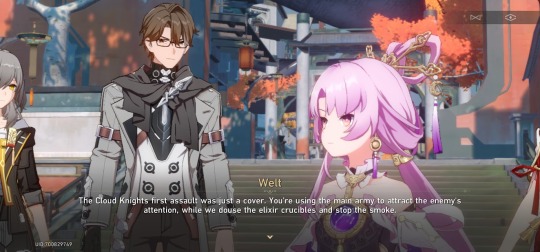
A precision, she asked the "unexpected guests" cit Jing Yuan because
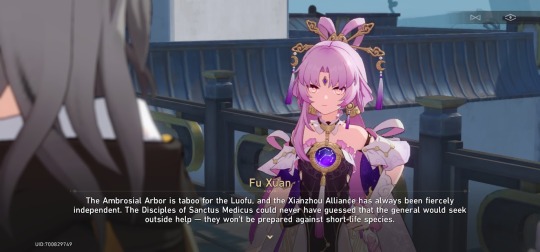
Never once she says that Tingyun was to help them, Tingyun's job was to bring them to places, like the Artisanship Commission or the Alchemy Commission. If you paid attention, while we walked to the crucibles there was a piece of conversation
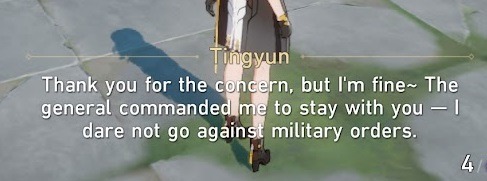


Here she sounds actually excited, while at the beginning Tingyun wasn't that happy to be in our company, she was nervous because the situation was unstable. So, here, I suppose, is Phantylia already talking. Or let more of her own personality shine.
Now, after the battle with Dan Shu, she said two things:


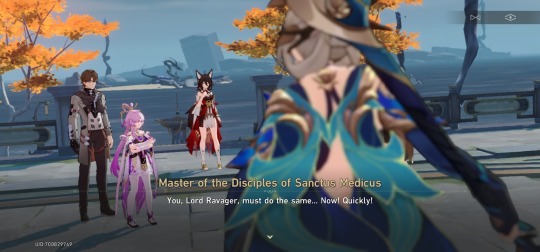
So, at first, it seems like Phantylia gave the Stellaron to the Disciples of Sanctus Medicus (DoSM for short) and made a promise with them. And it wouldn't be wrong to think this way, Phantylia is a Lord Ravager, a follower of Nanook, she should be able to have a Stellaron at ready. Actually, I read a very interesting post here on Tumblr about language, and I think that while the English translation is good, it may lose some context in between the translation. Like about the subjects of a phrase. The exact content of the promise between the DoSM and Phantylia is still missing, but we know one objective: fuse the power of the Abundance with the power of the Destruction.
And it's terrifying if you think about it: Destruction has a huge attack, Abundance can cure itself... and we already saw a character who has both: Blade, a character on the path of Destruction who is also struck with Immortality. In gameplay he sacrifices a part of his HP to do more damage, only to regain later.
Let's go back to Tingyun and Phantylia. Like Welt says, mostly to reassure both March and Stelle, there is no certain hint to say that Tingyun was working willingly with Phantylia, but without the body, we don't know.

Which is a good question. But, for me, no body, no death. It basically is a rule in writing a story: if you don't find the body, that character can always appear later. So, the fact that Phantylia didn't leave a body will lead only to one thing: the body was fake. If she left the body, Fu Xuan would have realized immediately that Tingyun's body wasn't the real deed. Which it will bring us, by doing a jump, directly to the last quest, the "funeral". We met a lot of people who knew Tingyun, but the entire thing about Tingyun left me with a bad taste in my mouth. Even Yukong says some things that contradict herself
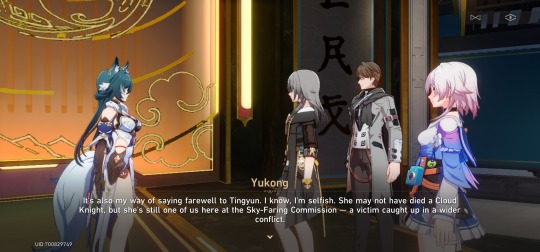
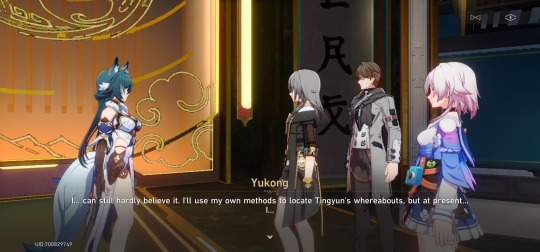
But, after some reconsideration, it has some strategy to that. Phantylia says "It would've been nice to observe a little longer" before revealing herself in her ghost-flame-like appearance. Possibly, Phantylia didn't want to reveal herself at all, let the DoSM and the Cloud Knights kill each other while she stays in the background and sees how the Xianzhou Loufu destroys itself from the inside. By declaring officially that Tingyun is dead, doing the all funeral and letting the Trio gives the news, it would destroy every other chances for Phantylia to use that face again. Meanwhile, Yukong would search for her but not in an official way. Strange that we didn't find any letter like the voiceline says, or maybe they didn't search her shop.

My considerations: they did everything to say that Tingyun is dead without saying explicitly, but I stand my ground and say Tingyun is not dead, not yet anyway.
But let's go back to the past, after this Trailblazer quest, the narrative switches its main character and we are back to Dan Heng! Like I said, he is the second main character on this arc and it was done perfectly.
Seriously, the switches between our characters, Dan Heng's parallel but different journey to his past... well done, HOYO.
Our more unlikely TRIO, Dan Heng, Sushang and Luocha, arrive in the same place, probably a few moments later our other trio left.

Sushang went back to the Cloud Knights, Luocha has one more deal to see and Dan Heng needs to leave before they ask who he is.
The past haunts Dan Heng, literally, the ghost of the past lives of the Vidyadhara appear to talk to him and Blade, the man he usually he runs from is waiting for him.


that woman, perhaps Jingliu?
The one thing I can't explain is the transformation in Imbibitor Lunae, why the change in clothes? Dan Heng wasn't fashionably enough with his regular clothes and needed a change? Anime Logic, I know.
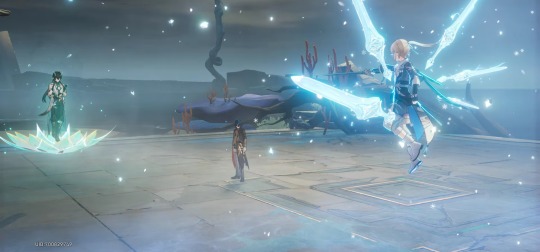
And poor Yanqing, that tries to fight literally legends, first Jingliu and now Dan Heng and Blade together.

Luckily, to babysit everyone there is Kafka. Look at Blade! He looks like someone who is regretting his choices.
Before reuniting with his friends, Dan Heng says a few words to Jing Yuan
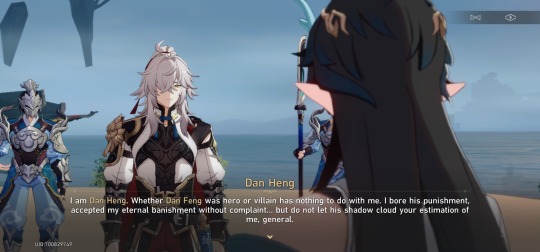
which is something really important. Dan Feng and Dan Heng are two different persons, even if Dan Feng didn't go through the hatching cycle. Right now, he is Dan Heng of the Astral Express and I was almost in tears in reading it, since there were many red flags about Dan Heng leaving the Astral Express Family. Even the scene that is a call back to the beginning, with March and Stelle's hands stretched out to Dan Heng was touching

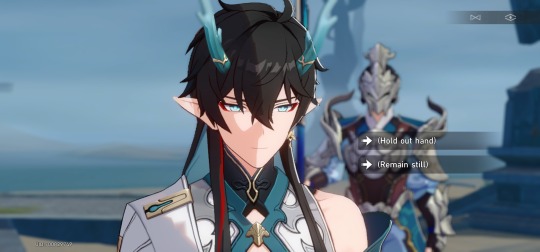
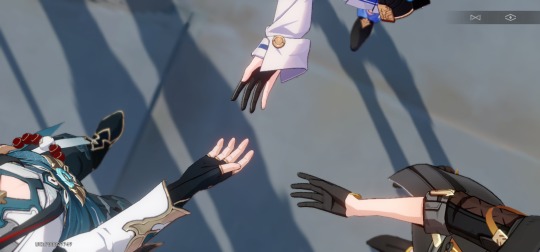
DO NOT SEPARATE! My babies çç
From here, everything seems to go fast. The cutscene with the music and the CGI that was the waves was so well done (basically all the money went to the waves), they went to fight Phantylia and what a fight it was. But unfortunately, our MC didn't get the power of the Hunt. Looking at how the story went, it was kind of assumed but not granted. The Xianzhou didn't lose faith in the Aeon of the Hunt, not like Cocolia did with Qlipoth. And in this Arc the moral protagonist was Dan Heng, with his past and his quest to accept but also move on with his future, it was not a time for our MC to get a power up. Maybe in the next world, unlike Genshin who has a fixed number of places (7 Archons, 7 Elements, 7 Nations etc), Honkai Star Rail is bigger, it has a lot more of Aeons and we have seen the powers of Aeon whose Path is not playable, who says that HOYO won't introduce more playable Paths?
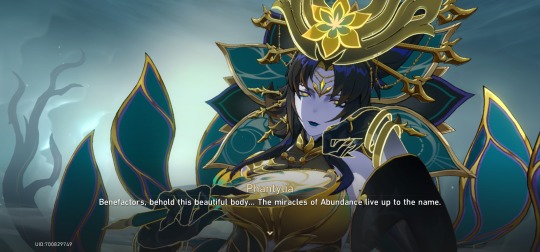
Phantylia is merely playing with us, she is barely amused with our performance. In terms of boss fights, Cocolia is more emotionally charged and the best for music. Phantylia is part of a bigger story, the same story that Elio scripted and Kafka is directing and, as Kafka said, we gained a powerful ally in the Xianzhou Luofu
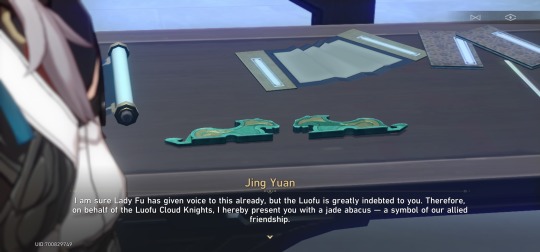


And I'm gonna bet that during the final fight with Nanook, the Xianzhou Loufu will appear as the cavalry, just like Jing Yuan did in the Dan Heng Companion Quest.
In the end, the Xianzhou Arc was different from Belobog Arc, the ending was unsatisfying because there were still a few things missing, and it didn't feel like an ending, like it did with Belobog with the nice pictures, it was more of a "see you later", so if I can guess, there will be another arc in the Xianzhou and it will be about the post cutscene.
I'm still a firm believer that Luocha is not Void Archives, but he played a part in this. He likely brought the Stellaron to the Xianzhou, possibly smuggled Jingliu to Xianzhou, all for destroying the Abundance.

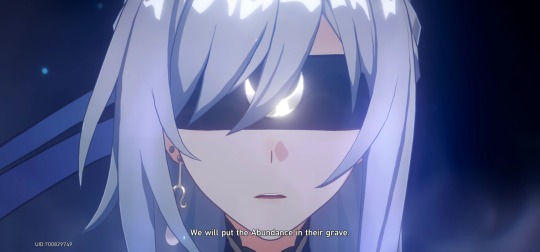
It was an incredible cliffhanger that leads to more questions than answers. We now assume that Luocha smuggled the Stellaron to the Xianzhou, Jingliu wasn't on the ship only to search for Blade, Jing Yuan needs a vacation and never comes back to his place as General.
So, final consideration: we are not over with the Xianzhou, even with our jade abacus, we will need to go back and in that time the MC will get the power of the Hunt. This arc is like a chapter 1, a chapter where we met most of its characters, it explained the conflict between Lan and Yaoshi, the problems that Yaoshi's gift left, it gave us the first glance to the bigger story with Elio and his Stellaron Hunters and their objective to kill Nanook. While Herta Space Station was a tutorial and Jarilo-VI was an opening act for the ways of trailblazing (a story that have a conclusion and we are only witness to their efforts to move on), Xianzhou is the very first big world where there wasn't a real ending. Yes, we stopped the Stellaron, but the conflict is still happening. We have more information about us, about one of our friends, we have met the Stellaron Hunters, talked to them (Silver Wolf is the more social of the group and has visiting rights!), but it's like we have gained nothing because there is still so much to do in the Xianzhou.
I'm sorry if this is too long, but for me it's important to say that the last quest we did in v1.3 wasn't the final quest for the Xianzhou, we just put a stop to Trailblaze more, but we will be back for a second chapter on that ship, after all "there is still more to explore".
#honkai star rail#honkai stelle#honkai march 7th#honkai dan heng#honkai luocha#honkai jing yuan#honkai jingliu#honkai star rail meta#give jing yuan a vacation#all of his past friends came to give him hell#honkai star rail theory#honkai welt
47 notes
·
View notes
Note
I'm sorry, Dan Shu was important?
- ☏
My neurodivergent ass can't tell if this is supposed to be sarcastic or a jab at Dan Shu's lack of screentime in 1.2
But yeah she was set up to be important in the first half of the Luofu Trailblaze Mission since there was a whole section where Trailblazer suddenly had to investigate the Disciples of Sanctus Medicus (DoSM) and then they dedicated screentime to her where TB has to spend time with her. She asks you to go on errands to help this blind girl and then you learn about her struggles as a blind person in the Xianzhou
You're even given two pieces of her diary which detail her past and reasons for becoming the leader of the DoSM
It was weird pacing honestly since it was so abrupt and March and Welt were just gone for some reason??
I recall that after 1.2 they sorta removed that arc from the main quest and turned it into a side quest you had to do before the main quest
Which is great but now it's weird to experience Dan Shu being set up to be important only to just be killed off without even giving her a spare thought.
9 notes
·
View notes
Text
Whatever you say ham youre dosm ill flip your shit in a frying pan. Daln i feel like the son of sam. Uncle Sam.
Kathryn making everyone break on set of The Studio and her reaction to finding out she was the one everyone said.
626 notes
·
View notes
Text
Average Salary and Cost of Living in Kuala Lumpur: A Low- to Middle-Income Perspective

Kuala Lumpur is Malaysia’s bustling capital and economic hub, boasting higher salaries on average than other states. However, the cost of living in KL is also substantially higher, squeezing the budgets of low- and middle-income earners. This article dives into the most recent data on average incomes in KL and provides a comprehensive breakdown of how people in this income range spend their money on necessities like housing, food, transportation, healthcare, insurance, entertainment, utilities, debt repayments, and (if possible) savings. We’ll also highlight the cost-of-living pressures they face, current savings trends, and common financial challenges, using authoritative sources such as the Department of Statistics Malaysia (DOSM) and Bank Negara Malaysia.
Income Levels in Kuala Lumpur: Focus on Low to Middle Earners
Higher Average Salaries, But Not Everyone Benefits: Kuala Lumpur residents generally earn more than the national average. As of late 2023, the median monthly salary for formal-sector employees in KL was around RM3,800 (BERNAMA - Kl, Selangor, Penang Record Median Monthly Salaries Exceeding National Rate). This is notably above the national median of about RM2,600 (Median monthly wages of Malaysia's formal sector employees in Q1 2023 | Human Resources Online). (In early 2023, KL’s median was reported even higher, at ~RM3,927 (Median monthly wages of Malaysia's formal sector employees in Q1 2023 | Human Resources Online).) What this means is that a typical individual worker in KL earns roughly RM3.8k a month – reflecting the city’s higher-paying jobs. Top earners pull this average up further; in fact, the mean household income in KL was RM13,325 in 2022 (with a median household income of ~RM10,234) ( Stats Dept: Average household income at RM8,479 in 2022 | Malay Mail ), far exceeding the national median household income of RM6,338 ( Stats Dept: Average household income at RM8,479 in 2022 | Malay Mail ) ( Stats Dept: Average household income at RM8,479 in 2022 | Malay Mail ). Low- to Middle-Income Definition: When we talk about “low- to middle-income” earners, we are roughly referring to the Bottom 40% (B40) and Middle 40% (M40) of the income distribution. In KL’s context, many in this group earn in the ballpark from the minimum wage (RM1,500) up to around the city’s median salary (RM3–4k range). It’s important to note that not everyone in KL enjoys a high salary – a large segment of workers earn modest wages despite the city’s wealth. National data shows that about 34.6% of Malaysian formal-sector workers earn below RM2,000 a month (BERNAMA - Kl, Selangor, Penang Record Median Monthly Salaries Exceeding National Rate), and although KL’s figure might be a bit lower due to higher average pay, a significant share of KLites still fall into this low-income bracket. These could be entry-level employees, service sector workers, gig economy workers, etc., for whom RM1,500–RM2,500 monthly incomes are common. Middle-income individuals in KL might earn between ~RM3,000 and RM6,000 (straddling the lower M40 range). Household vs Individual Income: Keep in mind, many households have more than one earner. DOSM reports the average Malaysian household has 1.8 income earners ( Stats Dept: Average household income at RM8,479 in 2022 | Malay Mail ). In Kuala Lumpur, a typical low/mid-income household might have two working adults whose combined income could be, say, RM4,000–RM6,000 (if each earns ~RM2–3k). That aligns with the median household income for KL. But whether it’s a single person or a small family, the real question is: how far does that income go in an expensive city like KL?
Cost-of-Living Pressures in KL
Earning a few thousand ringgit in KL doesn’t equate to living comfortably – rising costs of living have been eroding the purchasing power of these earnings. In recent years, expenses have grown faster than incomes for many households. Between 2019 and 2022, average household spending in Malaysia rose by 3.7% (compounded annually) while average household income grew only ~2.4% (DOSM: Household spending grew faster than incomes in 2019-2022, partly fuelled by EPF withdrawals, govt handouts) (DOSM: Household spending grew faster than incomes in 2019-2022, partly fuelled by EPF withdrawals, govt handouts). In other words, costs outpaced wages. The Department of Statistics noted that Malaysians had to finance some of this increased spending using “non-income” money – special EPF withdrawals and government cash aid during the COVID-19 pandemic (DOSM: Household spending grew faster than incomes in 2019-2022, partly fuelled by EPF withdrawals, govt handouts) – highlighting that normal incomes alone weren’t keeping up with expenses. Inflation Hits Hard: Part of the pressure comes from inflation, especially in essential items. Overall inflation in 2022 was 3.3%, but food prices jumped 5.8% that year (). For city dwellers in KL, food inflation was even higher (urban food inflation ~6.1% in 2022) (). This disproportionately hurts lower-income households because they spend a larger chunk of their income on food. Estimates show low-income households spend about 38% of their income on food, compared to around 27% for higher-income households (). So when food prices climb, poorer families feel the squeeze much more. Similarly, costs for utilities and fuel have risen, though Malaysia’s broad subsidies (for petrol, cooking oil, electricity, etc.) have cushioned some of the impact. Even so, by 2023 the government had to allocate over RM70 billion on subsidies and aid to alleviate living costs () (), an indicator of how serious the cost-of-living issue has become. Stagnant Incomes for the Poor: Not everyone’s income is growing. Data suggests that the poorest urban households in KL actually saw real income declines after the pandemic. Adjusted for inflation, the average monthly income of KL’s bottom 10% households dropped from about RM4,146 in 2019 to RM3,431 in 2022 (). (These are household figures; for context, RM3.4k is roughly what a low-income family in KL survives on per month.) This means the poorest families are worse off in purchasing power than they were before. It’s no surprise then that poverty rates ticked up – Malaysia’s overall poverty incidence was 6.2% in 2022 (vs 5.6% in 2019) (), and urban poverty remains a concern even in KL’s “rich” environment. Struggle to Make Ends Meet: A World Bank study underscored how precarious things are for low-income Malaysians: 7 in 10 low-income households struggle to meet monthly basic needs, and 6 in 10 have no savings at all (). This is a startling figure – essentially, the majority of the B40 are living paycheck-to-paycheck with nothing left to buffer against emergencies. Kuala Lumpur’s low/middle earners fit this profile: many find that after paying the rent, buying groceries, and covering transport, there’s little or nothing left of their salary. Before diving into exactly where the money goes, it’s useful to outline the typical spending pattern. Across Malaysia, households (on average) devote the bulk of their spending to a few key necessities. DOSM’s Household Expenditure Survey 2022 shows that about 66.9% of total household spending is concentrated in four main categories (DOSM: Household spending grew faster than incomes in 2019-2022, partly fuelled by EPF withdrawals, govt handouts): - Housing, Utilities & Other Fuels: ~23.2% of spending (DOSM: Household spending grew faster than incomes in 2019-2022, partly fuelled by EPF withdrawals, govt handouts) (this includes rent or mortgage, electricity, water, cooking gas, etc.) - Food & Non-Alcoholic Beverages (Groceries): ~16.3% (DOSM: Household spending grew faster than incomes in 2019-2022, partly fuelled by EPF withdrawals, govt handouts) (food consumed at home) - Restaurants & Hotels: ~16.1% (DOSM: Household spending grew faster than incomes in 2019-2022, partly fuelled by EPF withdrawals, govt handouts) (meals eaten out, takeaway, plus any spending on hotels) - Transportation: ~11.3% (DOSM: Household spending grew faster than incomes in 2019-2022, partly fuelled by EPF withdrawals, govt handouts) (fuel, public transport, vehicle expenses) The remaining ~33% is split among all other needs – including healthcare, education, communication (phone/internet), clothing, entertainment/recreation, insurance, personal care, etc. Low- to middle-income earners in KL tend to follow a similar pattern, although the exact proportions can vary (for instance, someone who doesn’t own a car might spend less on transport and more on food or vice versa). Let’s break down each major category and see how KL individuals manage their income in each area. (image)Figure: Average Malaysian household spending by category (2022). Essential expenses (housing, food, transport) make up the bulk of monthly costs (DOSM: Household spending grew faster than incomes in 2019-2022, partly fuelled by EPF withdrawals, govt handouts).
Housing: Rent, Mortgages and Utilities
Housing is typically the single largest expense for city dwellers. In Kuala Lumpur, the high cost of accommodation is a top concern for low- and middle-income earners. Nationally, housing and utilities account for about 23% of household expenditures (DOSM: Household spending grew faster than incomes in 2019-2022, partly fuelled by EPF withdrawals, govt handouts), the biggest share of any category. In KL, this percentage can be even higher in practice, because rents are well above the national average. Recent data show that the average rent in Kuala Lumpur is around RM2,863 per month (Report: Renters in Malaysia feel the pinch as average rent climbs nearly… | Kashif Ansari) for residential properties – about 44% higher than the Malaysian average rent. This figure might represent renting a typical apartment or condo in the city. For someone earning, say, RM3,500 a month, a RM2.8k rent is clearly unaffordable. As a result, lower-income KL residents must find strategies to reduce housing costs: many rent smaller flats or single rooms, live in the city’s outskirts (with longer commutes), or share apartments with roommates or extended family. Even with those adjustments, it’s not uncommon for low-income families in KL to spend 30% or more of their monthly income on housing and basic utilities. For example, renting a low-cost flat might be ~RM800, and utilities (electricity, water, waste) another RM150–RM200, on a household income of RM3,000 – that’s roughly one-third of the income gone. Middle-income households might be paying a mortgage or higher rent in the range of RM1,500–RM2,500, which still eats up a significant portion of a RM5k–RM6k income. The term “housing affordability” is often defined as housing costs not exceeding 30% of income; many KL households struggle to meet this benchmark. According to Bank Negara Malaysia, housing in urban centers has become severely unaffordable relative to incomes over the years, forcing many to either downsize living space or incur long-term debts for homeownership. Utilities (electricity, water, cooking gas) are typically counted together with housing costs by DOSM. These are essential bills that cannot be avoided. Malaysia’s electricity tariffs are subsidized for basic usage, but in KL’s hot climate, running fans or air-conditioning (even moderately) can lead to substantial electric bills. A middle-income family might pay RM150–RM250/month for electricity if using AC regularly; lower-income families in small units might keep it lower by using fans. Water is relatively cheap (often under RM30). Cooking gas cylinder refills and other utilities add a bit more. Additionally, most households now consider internet and mobile phone service a necessity – a monthly broadband and phone plan could be another RM100–RM200. When combined, these utility and communication expenses typically form part of that 23% housing/utilities segment (DOSM: Household spending grew faster than incomes in 2019-2022, partly fuelled by EPF withdrawals, govt handouts). They may seem small individually, but they add up and must be paid every month, further tightening the budget. In summary, shelter and utilities easily take up a quarter or more of a KL household’s spending. High rents are a pain point – in fact, there have been news reports of rents climbing nearly 4% in one quarter recently, as demand for city living rises post-pandemic (Report: Renters in Malaysia feel the pinch as average rent climbs nearly… | Kashif Ansari). For low-income earners, there are public housing programs and rent subsidies available on a limited basis, but many still end up in the private rental market where they have to compromise on location, space, or living conditions to make the rent each month.
Food: Groceries and Eating Out
Food is the next big expenditure pillar for Malaysians. We often divide this into two parts: groceries (food at home) and dining out. Both are significant in Kuala Lumpur. Groceries (Food at Home): Even though KL residents are surrounded by eateries, cooking at home is usually more economical, and most households will allocate a part of their income to market or supermarket purchases. On average, 16.3% of household spending goes to food and non-alcoholic beverages for home consumption (DOSM: Household spending grew faster than incomes in 2019-2022, partly fuelled by EPF withdrawals, govt handouts). For a family with RM4,000 monthly spending, that’s about RM650 on groceries. This covers staple foods (rice, noodles, bread), proteins (meat, eggs, tofu), vegetables, and other cooking needs. Low-income households tend to stick to essential, cheaper foods and buy in bulk or during promotions. However, over the past year or two, Malaysians have felt a sharp increase in grocery bills – eggs, chicken, vegetables, cooking oil, and other basics have all seen price hikes. With food inflation running ~5-6% in 2022 (), a ringgit buys less food than before. As a result, some families have had to adjust their diets (for example, reducing meat, buying cheaper canned foods, etc.) to stay within budget. Eating Out (Restaurants and Hawker Food): Malaysian culture includes a lot of eating out, and KL offers everything from mamak stalls and hawker centers to fancy restaurants. Based on DOSM data, about 16.1% of expenditures go to the restaurants & hotels category (DOSM: Household spending grew faster than incomes in 2019-2022, partly fuelled by EPF withdrawals, govt handouts) (which is mostly meals outside the home, since hotel stays for vacations would be occasional). This high share indicates that even average households spend nearly as much on eating out as on groceries. In an urban lifestyle, this could mean buying lunch at work every day, grabbing roadside nasi lemak for breakfast, or dining out on weekends. For low-income individuals, “eating out” doesn’t mean fancy restaurants – it’s often economical street food or budget mixed rice meals. A single person earning RM2,500 might spend, say, RM10 for lunch and RM10 for dinner on simple outside food each workday (that’s around RM400 a month), plus occasional coffees or snacks. It adds up quickly. Many have noted that eating out, while convenient, can consume a big chunk of income without one realizing it, especially given KL’s endless food options. However, when times are tough, dining out is one of the areas people can try to cut back. During the pandemic, many rediscovered cooking at home to save money. The data reflects this shift somewhat: DOSM noted a decrease in the share of spending on eating at home (from 16.9% in 2019 to 16.3% in 2022) and an increase in eating out (from 13.7% to 16.1%) (DOSM: Household spending grew faster than incomes in 2019-2022, partly fuelled by EPF withdrawals, govt handouts) – suggesting that by 2022, people were eating out more again as things reopened. For low-income households, eating out is often limited to cheap food stalls, but even those costs can strain a tight budget. Read the full article
0 notes
Text
Alpro Pharmacy and Believe Fitness Collaborate on Silver Sneakers Project to Enhance Elderly Well-being and Prevent Falls
KUALA LUMPUR, MALAYSIA – Media OutReach Newswire – 18 February 2025 – Malaysia’s aging population is growing at a faster-than-expected rate, with more than 17% of the population expected to be above the age of 60 by 2040 according to The Department of Statistics Malaysia (DOSM). This demographic shift indicates that more seniors will face mobility limitations, impacting their independence and…
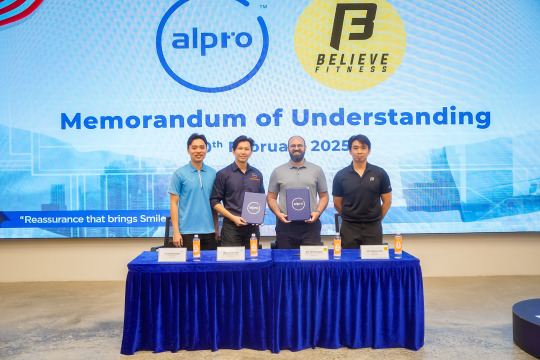
View On WordPress
0 notes
Text
I N NOTTY WEEDLL L BUT IV OCULF BR SO K UCH WRFRz. I NDR FYO GRT KIKT HTE FITDT TIME. I NCTRD TO HRY EORDE. I NEEBTO NOT BEBSBLR TO TJSE RIT SNYMOTR. OR I OWNT BELEIVR I M ILL. I NRED TOVGRT EOTFDE. FCUCK
BOTEHRIGNG PEOPME ALWSYS MAKES MR FEEL WORDEE. MATBE I DHOBILF FO THST. DOSM INBBOXXES. SPSMSPAM AND SPAM. PEORPEL HATTRRE SPAM. I LIKE IGT WHEN MY FTIENDS DO IT. BUT MOBODYS EVRRY L IVKRF SCOFLISR. NOVOCD YID BOSESSR WITH ME I NTHR DSME WAY I AM WITH TJEM. ICM GONING TO GO. HARASBDFI MOXES. I TBFGINK. YOU DOTN NEED TO REPLY. ILVOVE YOUU
0 notes
Text
Greening the Dragon: ISO 14001 Certification and Sustainable Success in Malaysia / Uncategorized / By Factocert Mysore

ISO 14001 Certification in Malaysia
ISO 14001 Certification in Malaysia, a Southeast Asian country seemed for its vibrant way of life and biodiversity, is experiencing speedy monetary growth. This progress, but, necessitates a focus on environmental duty. Here’s in which ISO 14001 certification emerges as a powerful tool for Malaysian agencies to gather sustainable achievement.
Beyond Compliance: The Malaysian Context
While adhering to environmental hints is vital, ISO 14001 in Malaysia gives more than clear compliance. It offers a framework for organizations to increase a sturdy Environmental Management System (EMS) that fosters a manner of lifestyle of environmental stewardship. This translates into quite a range of blessings:
Enhanced Brand Reputation: Consumers are increasingly more environmentally aware. ISO 14001 certification demonstrates a dedication to sustainability, boosting emblem photo and attracting eco-aware customers and traders.
Reduced Operational Costs: An EMS encourages useful resource performance, most important to reduced power and waste technology. This interprets to massive cost monetary savings over time.
Improved Risk Management: By proactively figuring out and addressing environmental dangers, groups can mitigate capability liabilities and disruptions.
A Competitive Edge: In current day worldwide marketplace, ISO 14001 certification can be a differentiator, taking off doorways to new markets and partnerships that prioritize sustainability.
The Greening Journey: A Practical Guide for Malaysian Businesses
The direction to ISO 14001 certification in Malaysia can be streamlined with the aid of using way of the following steps:
Commitment from Leadership: Active purchase-in from top control is vital. Leaders want to champion the environmental cause and allocate vital resources.
Gap Analysis: Assess your cutting-edge-day environmental practices within the route of the ISO 14001 requirements. Identify regions for development and increase a roadmap for closing the gaps.
Developing the EMS: Establish an EMS tailor-made to your industrial company corporation’s unique needs. This consists of setting environmental policies, goals, and dreams.
Implementation: Put your EMS into motion. This includes operational changes, worker schooling, and putting in tracking and size techniques.
Internal Audit: Conduct ordinary inner audits to make sure the EMS is functioning effectively and find out regions for non-forestall development.
Management Review: Hold periodic manage evaluations to assess the general everyday performance of the EMS and make strategic adjustments.
Certification Audit: Engage with a Department of Standards Malaysia (DOSM)- everyday certification frame for a formal audit. Upon a success very last contact, you could get keep of the coveted ISO 14001 certification.
Uniquely Malaysian Considerations:
While the middle requirements of ISO 14001 remain normal, here are some components to hold in mind within the Malaysian context:
Compliance with Malaysian Environmental Regulations: Ensure your EMS integrates seamlessly with present environmental suggestions much like the Environmental Quality Act (EQA) 1974.
Engaging the Local Community: Consider the environmental worries of the nearby organizations that you feature. Incorporate their comments into your environmental guidelines.
Embracing Green Technologies: Malaysia is actively selling green-era adoption. Explore incorporating innovative solutions like renewable strength or waste-to-useful aid technologies into your EMS.
Beyond Certification: A Sustainable Future
ISO 14001 certification in Malaysia is a stepping stone in the direction within the course of a prolonged period of environmental sustainability. Here’s how companies can construct on this achievement:
Continuous Improvement: Don’t view certification as an endpoint. Continuously looking for techniques to refine your EMS and enhance your environmental performance.
Sustainability Reporting: Develop complete sustainability reviews that display off your environmental willpower and development.
Collaboration: Partner with one of the types of environmentally aware companies to promote first-rate practices and accelerate collective effect.
Conclusion
By embracing ISO 14001 certification, Malaysian organizations can release a prevailing technique: attaining financial achievement whilst safeguarding the environment for future generations. This determination to achieve a sustainable future will ensure that Malaysia remains a thriving economic and ecological powerhouse in Southeast Asia.
Why Factocert for ISO 14001 Certification in Malaysia?
We provide the best ISO consultants Who are knowledgeable and provide the best solution. And to know how to get ISO certification. Kindly reach us at [email protected]. work according to ISO standards and help organizations implement ISO certification in Malaysia with proper documentation.
For more information, visit ISO 14001 Certification in Malaysia.
RELATED LINKS
ISO certification in Malaysia
ISO 9001 certification in Malaysia
ISO 14001 certification in Malaysia
ISO 45001 certification in Malaysia
ISO 13485 certification in Malaysia
ISO 27001certification in Malaysia
ISO 22000 certification in Malaysia
CE Mark certification in Malaysia
0 notes
Text
My name is Tanya/Kaz or you can call me vex too I uh draw I guess.
Here’s my Caard and pronoun-page
My DMs are always open and my personal is @coctyusheart
Some (but not limited to) fandoms I like (plus tags); (And my OC universes below that)
Voltron, PJO, various musicals like Heathers, BMC, Hades town ect. Danganronpa, genshit, Honkai, ace attorney, hazbin hotel, helluva boss, Undertale, HADES, dungeons and dragons, homestuck, bg3, JJBA, MLP, mythologies, Skyrim, and more tbh.
I really like cats and all animals :3 too.
~
Anyway as my ocs go;
MML: mirrors of monochrome lights
| 7 young adults in college who went to highschool together get swept into a weird situation in which they end up in a magical world that acts like they’ve been there the whole time and has people they know
| everyone is gay or sumn or bipoc except Peter he’s the token straight
Main Cast; Vanessa F, Persephone K, Giovanni T, Radha J, Drago S, Amai A, Peter A.
DOSM: Ditchotomy of sun and moon
This was intended to be made as a video game however…I do not have that skill set.
| you play as Moss, as you land in Chicago after the calamity 20 years ago, with little to no memories and people seem to be sorted into three Catergories.
| The gold who prefer the Sun kingdom, and have been deemed morally good, and/or socially accepted have received the gift of natural talent. Gold and very subtle sparkles in the arm
| the Star: the neutral who can go where ever they please but the town is considered neutral territory. They are the middle grounds, socially and morally can go either way. They have grey arms and the power of diplomacy.
| the moon: for thoes go are outcasted, demonized or have committed to darker morals, (usually it’s just outcasts tbh) and they frequently reside in the town, the town wood or the Moon kingdom. They have received the gift of magic which correlated to marking on thier arms.
Main cast: Moss (the mc), Vanessa (another one ik), Kevin, Zerena, Nico.
#skyrim#octopath traveler#voltron#fairy tail#jjba#danganronpa#ace attorney#musicals#pjo#pjo hoo toa#hazbin hotel#helluva boss#harry potter#hades game#hades 2#greek mythology#mlp#dnd#homestuck#bg3#honkai star rail#genshin impact#god of war#slime rancher#rwby#bsd#various final fantasies#ever after high#angels of death#artist intro
3 notes
·
View notes
Text
Malaysia’s nominal GDP in 2023 amounts to RM1.8 trillion
PETALING JAYA: In 2023, Malaysia’s nominal GDP reached RM1.8 trillion, marking a 1.6% growth, down from 15.8% in the previous year. Chief Statistician Malaysia Datuk Seri Dr. Mohd Uzir Mahidin highlighted that despite the slower growth, the economy remained resilient, driven by a 6.7% increase in private final consumption expenditure. This increase was supported by improved employment and a new…
0 notes
Text
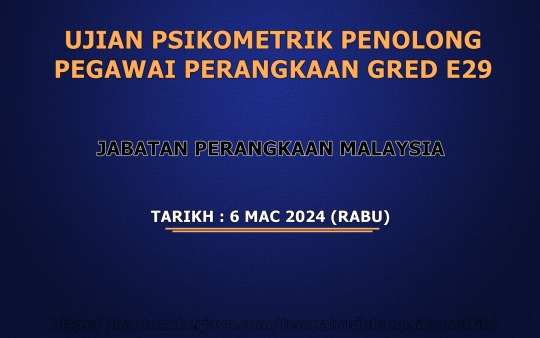
Panggilan Ujian Psikometrik Penolong Pegawai Perangkaan Gred E29 Jabatan Perangkaan Malaysia (DOSM) bagi tahun 2024. Semak panggilan anda sekarang!
Lawati: https://www.ptdexam.com/psikometrik-penolong-pegawai-perangkaan-gred-e29-dosm-2024/
0 notes
Text
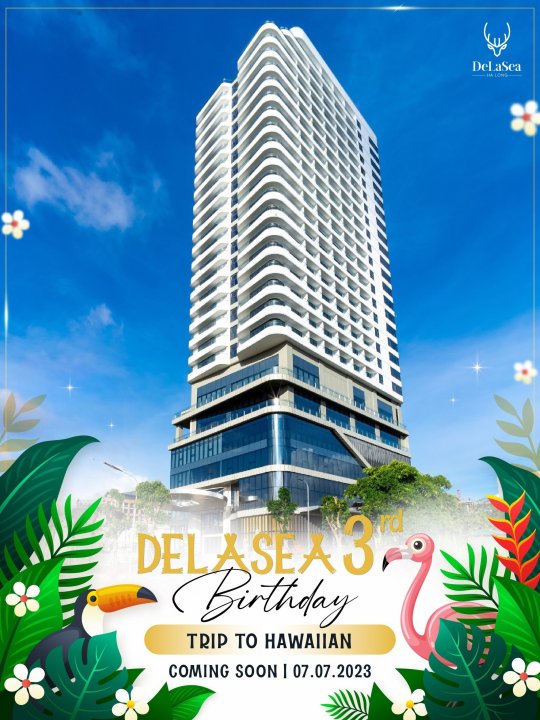
🎂 Tháng 7 sinh nhật, mời bạn bước lên chuyến tàu DeLaSea's Hawaiian đi đến xứ sở của những trải nghiệm nghỉ dưỡng thượng lưu cùng nhiều chương trình ưu đãi hấp dẫn tri ân khách hàng và đánh dấu cột mốc nâng cấp thương hiệu mới.
✨ Đặc biệt đêm tiệc “DeLaSea 3rd Birthday - Trip to Hawaiian” diễn ra vào ngày 07/07/2023 ghi dấu chặng đường 3 năm hình thành và phát triển. Follow fanpage cùng đón chờ những điều thú vị sắp được bật mí nhé.
🎂 This July birthday, we honorably invite you to join us on DeLaSeas Hawaiian train to experience the ultimate luxury resort getaway. As a special thank you for your continued support, we are offering many attractive promotions to enhance your stay and celebrate our new brand upgrade milestone.
✨ Especially, we are especially excited to announce our upcoming “DeLaSea 3rd Birthday - Trip to Hawaiian” party night on July 7th, 2023, marking the 3-year journey of establishment and development. Follow our fanpage for not missing our exciting updates in the future.
.
DeLaSea Ha Long Hotel ☎ 0866850086 | (+ 84-203) 6 503 289 🏨 A9, Lô 1, Đại Lộ Hạ Long Marine, Bãi Cháy, Hạ Long 📨 [email protected]
0 notes
Photo










ULTIMATE COMICS : DEATH OF SPIDER-MAN #160
#peter parker#norman osborn#bobby drake#USM#ultimate spider man#ultimate spider-man#death of spider-man#DoSM#🕷⎛ do it. click it. play it. twip it. BOP IT. 'blog it ! | allowed to reblog ⎠#🕷⎛ ch: norman osborn ⎠#🕷⎛ a boy of responsibility. a man to live forever with it | visage ⎠
10 notes
·
View notes
Text
Malaysia's wholesale, retail trade sales rise 3.9% in Q1
Malaysia’s wholesale, retail trade sales rise 3.9% in Q1
KUALA LUMPUR: Malaysia’s wholesale and retail trade sales registered a growth of 3.9 per cent year-on-year (yoy) in the first quarter of 2022 (Q1 2022), said the Department of Statistics Malaysia (DOSM). Chief statistician Datuk Seri Dr Mohd Uzir Mahidin said the increase was attributed to the motor vehicles sub-sector which rose 8.8 per cent, followed by retail and wholesale trade which rose 5.1…

View On WordPress
0 notes
